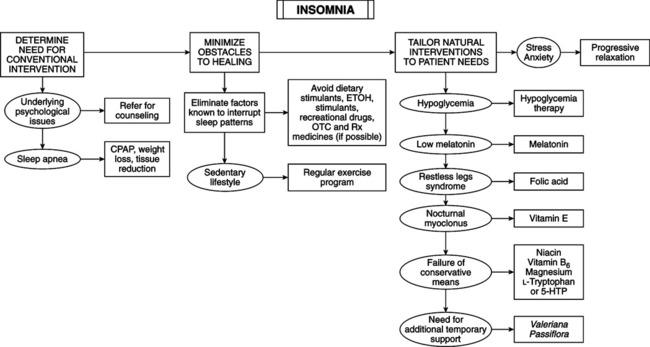Insomnia is an extremely common complaint with many causes. *The boundary between the categories is not entirely distinct. • Up to 30% of the population suffers. A total of 12.5% of the adult population uses prescribed anxiolytics or sedative hypnotics. Half of these drugs, especially benzodiazepines, are prescribed by primary care physicians. • Psychological factors account for 50% of insomnia cases evaluated in sleep labs and are closely associated with affective disorders (see the chapter on affective disorders). Cognitive therapy is often indicated and can improve sleep quality. • Insomnia may be a presenting symptom for a more serious condition. Conduct thorough history taking and examination, including details on recreational, prescription, and nonprescription drug use plus dietary and beverage history to identify stimulants or other agents known to interfere with sleep: thyroid pre-parations, oral contraceptives, beta-blockers, marijuana, alcohol, coffee, tea, chocolate. • Consider and rule out narcolepsy and sleep apnea syndromes. • Sleep apnea is the most common type of sleep disordered breathing. It is characterized by brief interruptions of breathing during sleep, with snoring between apnea episodes (not everyone who snores has this condition) or choking sensations. Frequent sleep interruptions prevent deep, restorative sleep, causing excessive daytime sleepiness and early morning headache. • An estimated 18 million Americans suffer from sleep apnea. • Associated issues: daytime fatigue, irregular heartbeat, hypertension, myocardial infarction, stroke, loss of memory function, other intellectual deficits. • Patient usually is unaware and incredulous when told. Sleep partner notes heavy snoring or interrupted breathing. • Definitive diagnosis: sleep disorder specialist in a sleep lab. • Cause is excess fatty tissue accumulated in airway, causing it to be narrowed, leading to heavy snoring, periods of no breathing, and frequent arousals (causing abrupt changes from deep sleep to light sleep). Ingestion of alcohol and sleeping pills increases the frequency and duration of breathing pauses in people with sleep apnea. In some cases sleep apnea occurs even if no airway obstruction or snoring is present. This form of sleep apnea is called “central sleep apnea” and is caused by a loss of perfect control over breathing by the brain. In both obstructive and central sleep apnea, obesity is the major risk factor and weight loss is the most important aspect of long-term management. People with sleep apnea have periods of anoxia (oxygen deprivation of the brain) with each apneic episode, which ends in arousal and a reinitiation of breathing. Seldom does the sufferer awaken enough to be aware of the problem. However, the combination of frequent periods of oxygen deprivation (20 to several hundreds of times per night) and the greatly disturbed sleep can greatly diminish the quality of life and lead to serious problems. The most common treatment of sleep apnea is the use of nasal continuous positive airway pressure (CPAP). In this treatment the patient wears a mask over the nose during sleep, and pressure from an air blower forces air through the nasal passages. The air pressure is adjusted so that it is just enough to prevent the throat from collapsing during sleep. The pressure is constant and continuous. Nasal CPAP prevents airway closure while in use, but apnea episodes return when CPAP is stopped or used improperly. Surgery for reducing soft tissue in the throat or soft palate should only be used as a last resort because often it does not work or can make the condition worse. Laser-assisted uvulopalatoplasty is a highly promoted surgical option. In this procedure lasers are used to surgically remove excessive soft tissue from the back of the throat and from the palate. This procedure initially works well in approximately 90% of those with sleep apnea, but within 1 year many people are the same or even worse than before because of scar tissue that invariably occurs. • Normal sleep patterns repeat themselves on a 24-hour cycle, of which sleep constitutes one third. Sleep tends to decrease with age, but whether this is normal is unknown. A 1-year-old baby requires 14 hours of sleep, a 5-year-old 12 hours, and adults 7-9 hours. Women require more sleep than men; the elderly sleep less at night but doze more during day than younger adults. • Two distinct types of sleep (based on eye movement and electroencephalographic (EEG) recordings): rapid eye movement (REM) and non-REM sleep. — REM sleep: eyes move rapidly and dreaming takes place; when people are awakened during non-REM sleep, they report they were thinking about everyday matters but rarely report dreams. — Non-REM sleep: four stages graded 1-4 on the level of EEG activity and ease of arousal. As sleep progresses, it deepens and brain wave activity is slower until REM sleep, when the brain suddenly becomes much more active. In adults, the first REM cycle is triggered 90 minutes after going to sleep and lasts 5-10 minutes; EEG patterns return to non-REM for another 90-minute sleep cycle.
Insomnia
GENERAL CONSIDERATIONSI
Sleep-Onset Insomnia
Sleep-Maintenance Insomnia
Anxiety or tension
Depression
Environmental change
Environmental change
Emotional arousal
Sleep apnea
Fear of insomnia
Nocturnal myoclonus
Phobia of sleep
Hypoglycemia
Disruptive environment
Parasomnias
Pain or discomfort
Pain or discomfort
Caffeine
Drugs
Alcohol
Alcohol

Sleep Apnea
Normal Sleep Patterns
![]()
Stay updated, free articles. Join our Telegram channel

Full access? Get Clinical Tree


Insomnia
